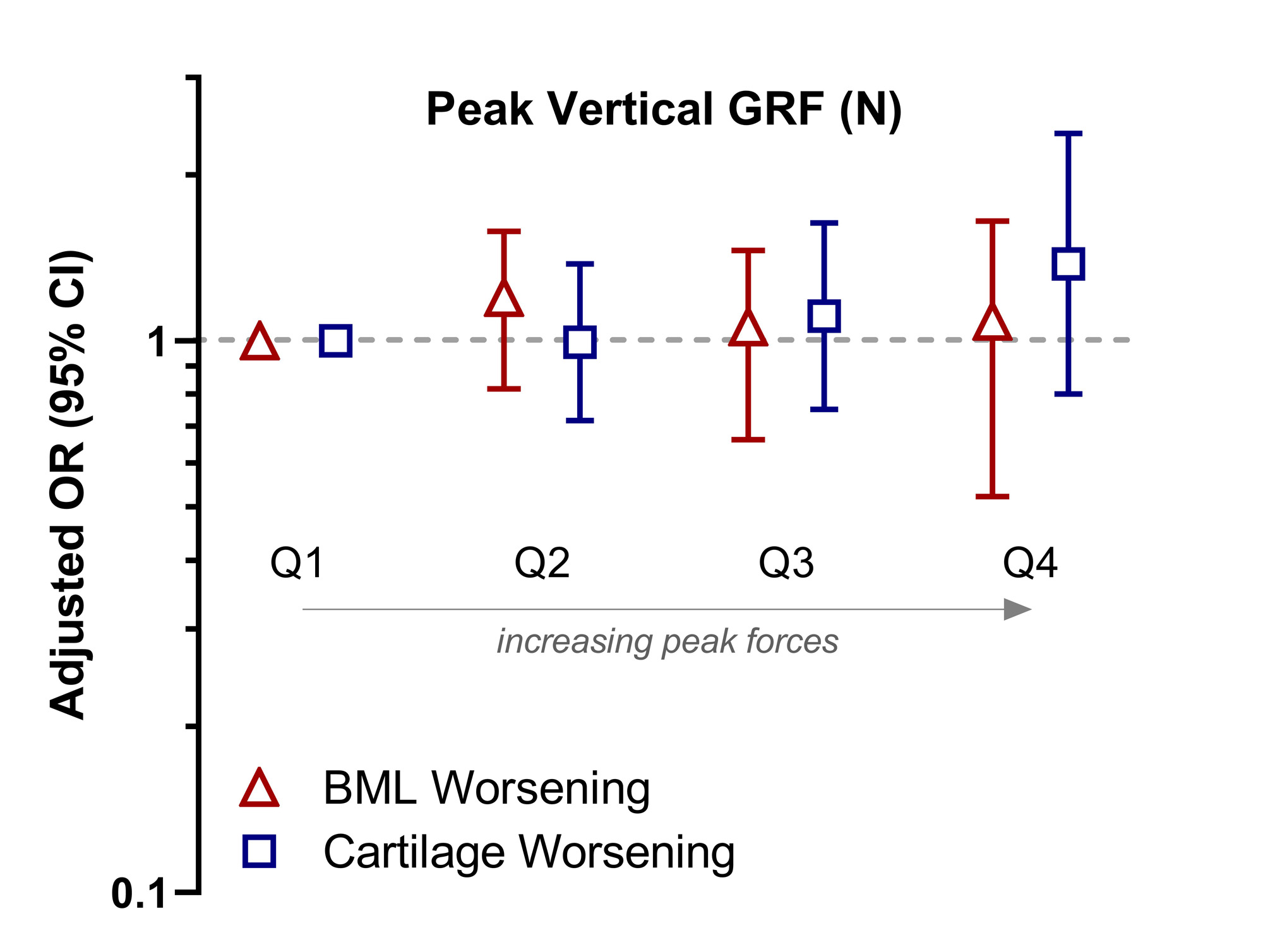Session Information
Session Type: Poster Session B
Session Time: 9:00AM-11:00AM
Background/Purpose: Mechanical loading is an important, modifiable risk factor for knee osteoarthritis (OA). Walking loads have been previously proposed as a risk factor for developing OA; however, there is a scarcity of literature exploring the longitudinal relation of baseline walking kinetics on structural worsening in the knee joint. Thus, our purpose was to analyze peak vertical ground reaction force (GRF) and average slope of the force (i.e., average loading rate (ALR)) during walking in persons with and without knee OA, and to explore the relation of these exposure variables to changes in MRI-based structural outcomes two years later. We hypothesized that increased peak GRF and ALR would be associated with greater odds of MRI-based structural worsening.
Methods: Data from the Multicenter Osteoarthritis Study (MOST), an NIH-funded cohort study, were used. Participants were included if they had walking GRF data at baseline (i.e., year 12 of MOST) and had obtained knee MRIs at baseline and follow-up (i.e., years 12 & 14 of MOST). Participants were excluded if they underwent total knee arthroplasty of either knee, whether prior to or during the study period.
Peak vertical ground reaction force (GRF) and average loading rate were evaluated during the first ~10% of the gait cycle following initial contact, averaged across four trials per knee, grouped into sex-specific quartiles (Q1-Q4), and analyzed in relation to structural outcomes. MRIs were read paired by experienced musculoskeletal radiologists using the MOAKS scales. Structural worsening was operationalized in two ways: (1) increase in size of bone marrow lesions (BMLs); and (2) cartilage worsening, defined as an increase in cartilage score anywhere in the knee including incident damage. BML and cartilage worsening were separately dichotomized as Y/N (i.e., any increase in BML size or any cartilage loss) at 2-year follow-up. Analyses were conducted using logistic regression adjusting for specific covariates (gait speed, age, sex, body weight, race, and mechanical alignment). For both exposure variables, peak GRF and ALR, Quartile 1 is the reference group and represents the lowest magnitudes of force and loading rate.
Results: 1577 participants (age: 61(9) years, BMI: 28(5) kg/m2; 56% female, 86% white) met criteria for inclusion; 8 observations were removed from analyses due to missing exposure and/or outcome data. At follow-up, 46% had BML worsening, and 45% had cartilage worsening. There were no between-quartile differences (p=0.29-0.69) or linear trends for BML worsening in either of the exposure variables (Chi Square=0.04-0.54, p=0.46-0.83). The odds of cartilage worsening were 11% higher in Q3 and 38% higher in Q4 of peak GRF (see figures) (test for linear trend: Chi Square=1.23, p=0.27). For ALR, the odds of cartilage worsening were 19% higher for Q3 and 21% higher for Q4 (test for linear trend: Chi Square=1.85, p=0.17).
Conclusion: Peak vertical GRF and GRF loading rate were not associated with worsening BMLs in the knee joint in persons with mild or no knee OA. Though not significant, the odds of cartilage worsening suggest a modestly elevated risk of cartilage worsening at higher peak GRF and higher loading rates when walking.
To cite this abstract in AMA style:
Sara L, Felson D, LaValley M, Rabasa G, Lewis B, Lynch J, Segal N, Guermazi A, Roemer F, Stefanik J, Lewis C. The Association of Peak Forces and Loading Rates During Walking with MRI-Based Structural Worsening of the Knee: The Multicenter Osteoarthritis Study [abstract]. Arthritis Rheumatol. 2023; 75 (suppl 9). https://acrabstracts.org/abstract/the-association-of-peak-forces-and-loading-rates-during-walking-with-mri-based-structural-worsening-of-the-knee-the-multicenter-osteoarthritis-study/. Accessed .« Back to ACR Convergence 2023
ACR Meeting Abstracts - https://acrabstracts.org/abstract/the-association-of-peak-forces-and-loading-rates-during-walking-with-mri-based-structural-worsening-of-the-knee-the-multicenter-osteoarthritis-study/


